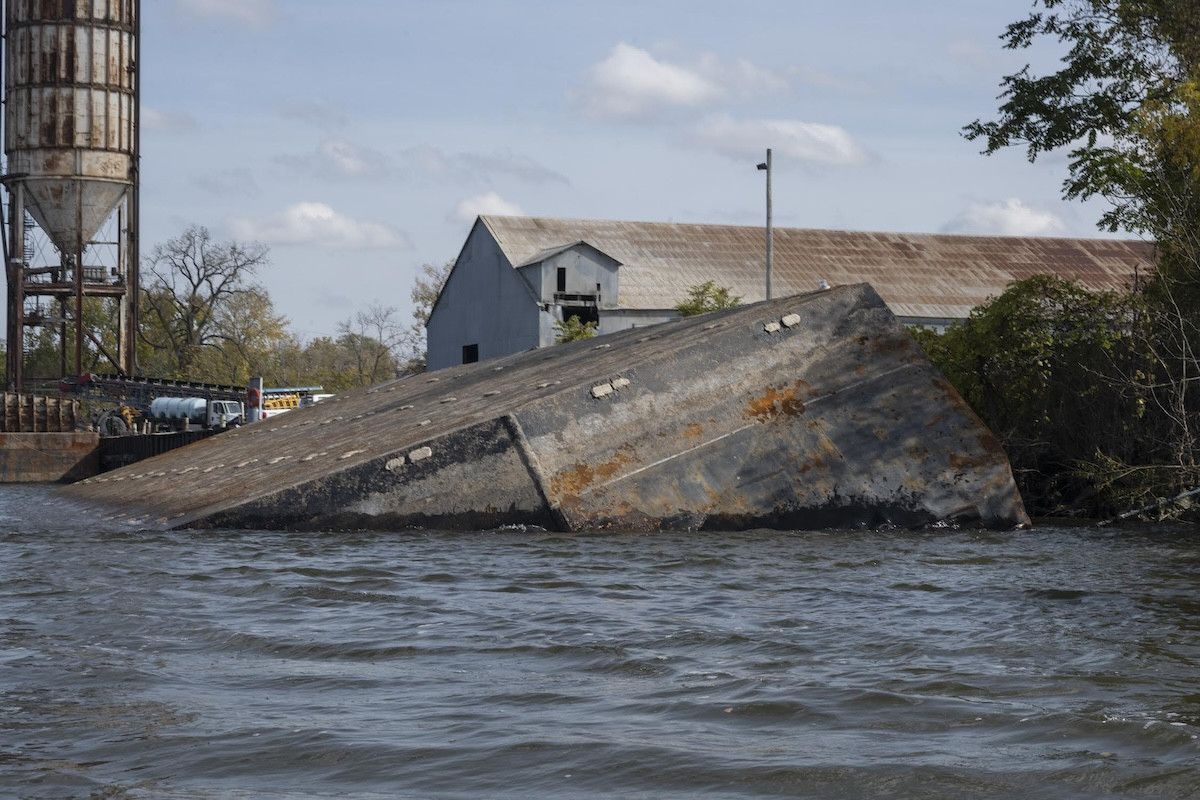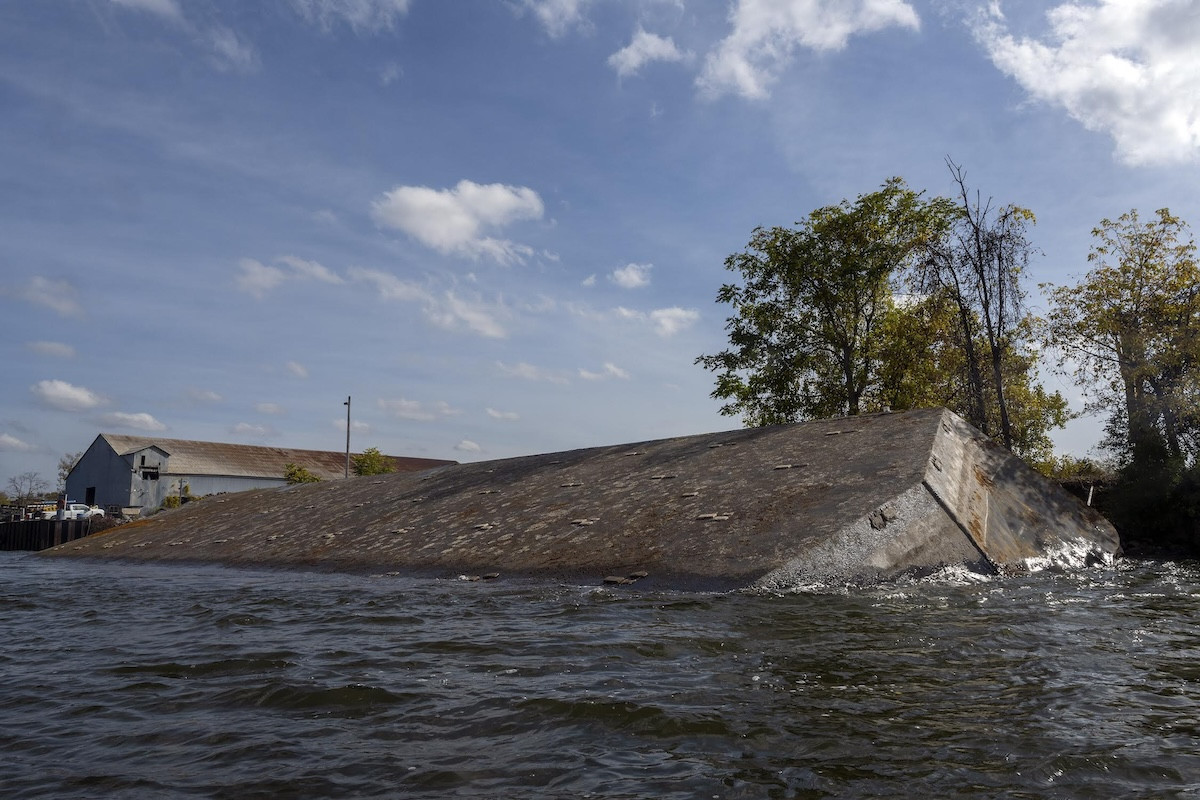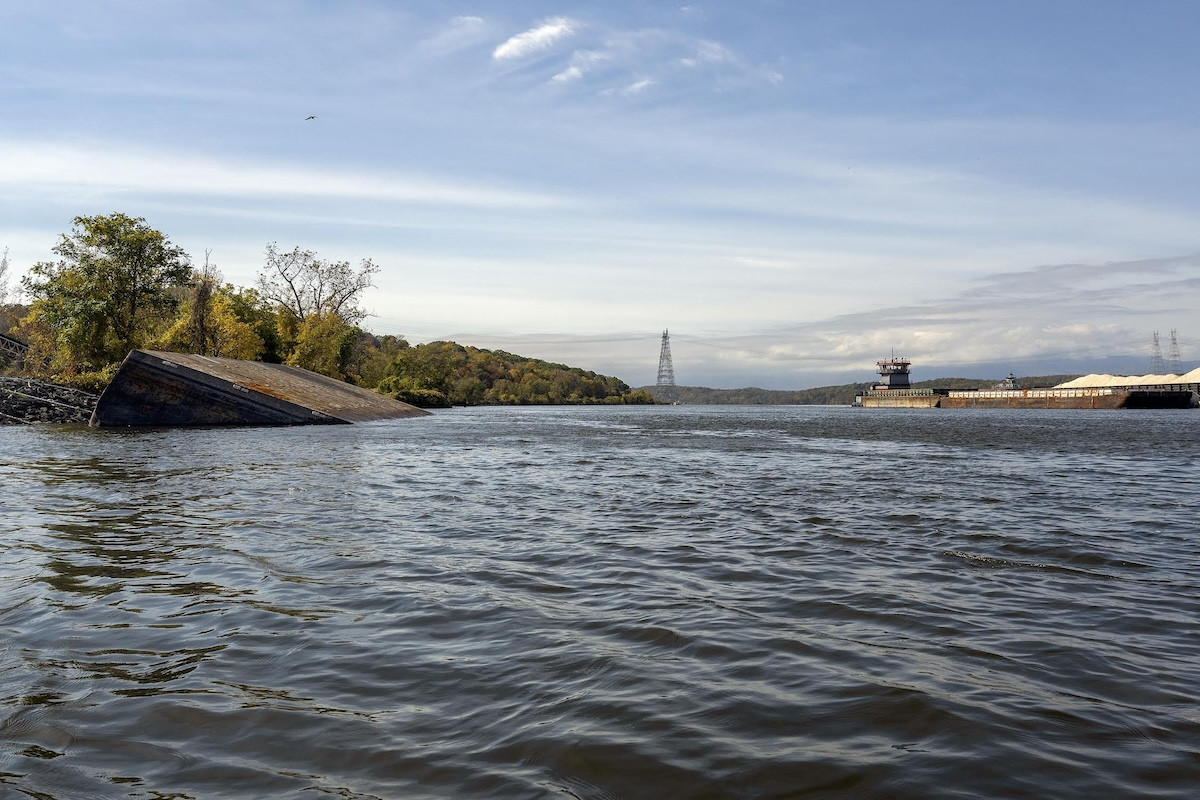A Capsized Barge and the Future of Hudson’s Waterfront Plans Stuck in the Mud
A gravel barge has gone belly up at the Hudson Port and, potentially, so too has the city's guiding waterfront legislation.

A gravel barge has gone belly up at the Hudson Port and, potentially, so too has the city's guiding waterfront legislation.

A little over a week ago, a gravel barge capsized and partially sank beside Hudson’s deep-water port, along with its load of crushed stone. The half-submerged vessel, now being removed, has become a fitting metaphor for the city’s waterfront quagmire: A heavy industrial presence listing and spilling into the very river that gives Hudson its identity.
The incident, though relatively minor and contained, comes at a moment when the city’s efforts to control the scale of industrial activity at its port are themselves taking on water. The future of Hudson’s waterfront, and perhaps its decades-long planning framework, now hinges on whether the city’s Local Waterfront Revitalization Program (LWRP) actually has the force of law.

At a tense Planning Board meeting days after the barge went down, the board’s attorney, Victoria Polidoro, asserted that the LWRP zoning might not be legally enforceable at all. She argued that while the Common Council adopted the LWRP in 2011, the city never filed an official map with the state. “There’s no LWRP area,” she says. “So even though we have provisions, there’s no area that triggers those provisions.” In her interpretation, Hudson’s waterfront rules “don’t carry the force of law, because there’s no area that it is being applied to.”
That technicality could render the city’s entire waterfront zoning framework effectively toothless just as the Planning Board prepares to decide whether the gravel company A. Colarusso & Sons may expand its operations. Mayor Kamal Johnson, who has publicly supported measured restrictions on port activity, wants to stay out of the deliberations of the Planning Board he appointed. “I would like to see a lot of these restrictions get placed,” he said on Monday. “The mayor’s office can approve plans based on what they decide, but we can’t really make things go faster when it comes to the Planning Board.”

Hudson’s waterfront wars are hardly new. In the early 2000s, residents banded together to stop a proposed cement plant that would have dominated the city’s waterfront presence. The LWRP that followed, adopted in 2011, was designed to strike a balance: Preserve limited industrial use at the deep-water dock while steering new development toward recreation, housing, and tourism. Under the plan, Colarusso’s gravel loading operation was designated a “nonconforming” use, permitted to continue but not expand.
That balance began to erode in 2014 when Colarusso repaired the dock’s bulkhead without proper city approvals, forfeiting its grandfathered status and triggering the need for a conditional use permit. The permit process has since stretched across years of litigation, studies, and heated public hearings. Residents complain of truck noise, dust, and diesel fumes drifting over Riverfront Park and anchor businesses in the district like Basilica Hudson, Kitty’s, and the Caboose. Developer Ben Fain, whose nearby projects represent tens of millions in investment, says some of his plans depend on curbing the scale of Colarusso’s operations. “All that work, all that time and effort by a community that came together, is all null and void if this reading is accurate,” Fain says of Polidoro’s legal interpretation. “I’m at the fourth stage of grief. The only thing left is acceptance—but I’m not ready for that.”
Fain describes Polidoro’s opinion as “catastrophic” for Hudson’s future, arguing that it could undermine not just the dock restrictions but every zoning decision based on the LWRP’s existence, including his own plan to build housing, a grocery store, and more.

The uncertainty has ripple effects beyond the dock. Nowhere is that more immediate than at the old Dunn warehouse, the hulking, long abandoned 19th-century brick structure beside the park that city leaders once envisioned as a cultural and community hub. A redevelopment plan, including a public pool and market space, had secured grant funding and early investor interest, but the legal and environmental wrangling next door chilled enthusiasm. “The Dunn warehouse could have been a jewel for the area,” Fain says. “Instead, it’s just sitting there.”
The city has reopened its Request for Proposals for the site, and Fain is preparing to submit a new plan—on one condition. “We’re going to put in for it, but only if the Planning Board puts restrictions on the volume at the dock,” he says. Otherwise, the multimillion-dollar investment he envisions is a no-go. “Nobody can really invest in that site if there’s no conditions on the dock.”

Mayor Johnson has tried, once, to broker a compromise. Earlier this year, he gathered Colarusso representatives, local advocates, and developers for a closed-door meeting in hopes of finding common ground on restrictions. “We tried to get everybody in the room and kind of rectify it, but it just was not successful,” he says. “It’s one of those things that’s going to have to play out in court one way or the other.”
Johnson’s political calculus is complicated. While he supports restrictions, he says he cannot legally direct the independent Planning Board, and his office must tread carefully to avoid influencing an active case. He says he has turned the barge investigation over to the city’s code enforcement officer, who is liaising with the Coast Guard and the state DEC to ensure the vessel’s removal. Fortunately, the barge carried no fuel, and officials report minimal environmental impact.
Still, the optics are hard to ignore: a half-sunk barge, an aging warehouse, a mayor’s limited power, and a zoning law whose very existence is in doubt. There's a lot of uncertainty right before a pivotal election where Johnson has already lost the Democratic primary and is running to retain his office on the Working Families Party line. The liberal city’s Democratic party has fractured and the waterfront issue has provided another wedge between those who support the Mayor’s tenure and those looking to depose him.

No timeline has been set for the Planning Board’s decision on Colarusso’s permit. Whenever it comes, the ruling will almost certainly spark another round of legal appeals. For residents who spent years shaping the LWRP, the notion that it may not hold legal weight is both baffling and demoralizing. If Hudson’s long-term plan for its riverfront can dissolve over a missing map, what was all the effort for?
Environmental advocates fear that without enforceable limits, the river’s ecosystem and Riverfront Park will bear the brunt of increased industrial traffic. Business and tourism supporters see a waterfront of squandered potential. And yet few relish the idea of driving out a century-old local company or jeopardizing jobs.
For now, Hudson remains adrift. The barge still lies half-buried in silt, waiting to be hauled out. So too does the city’s vision of a balanced waterfront—not sunk, but not yet freed from the muck, waiting for a shift in the tide.